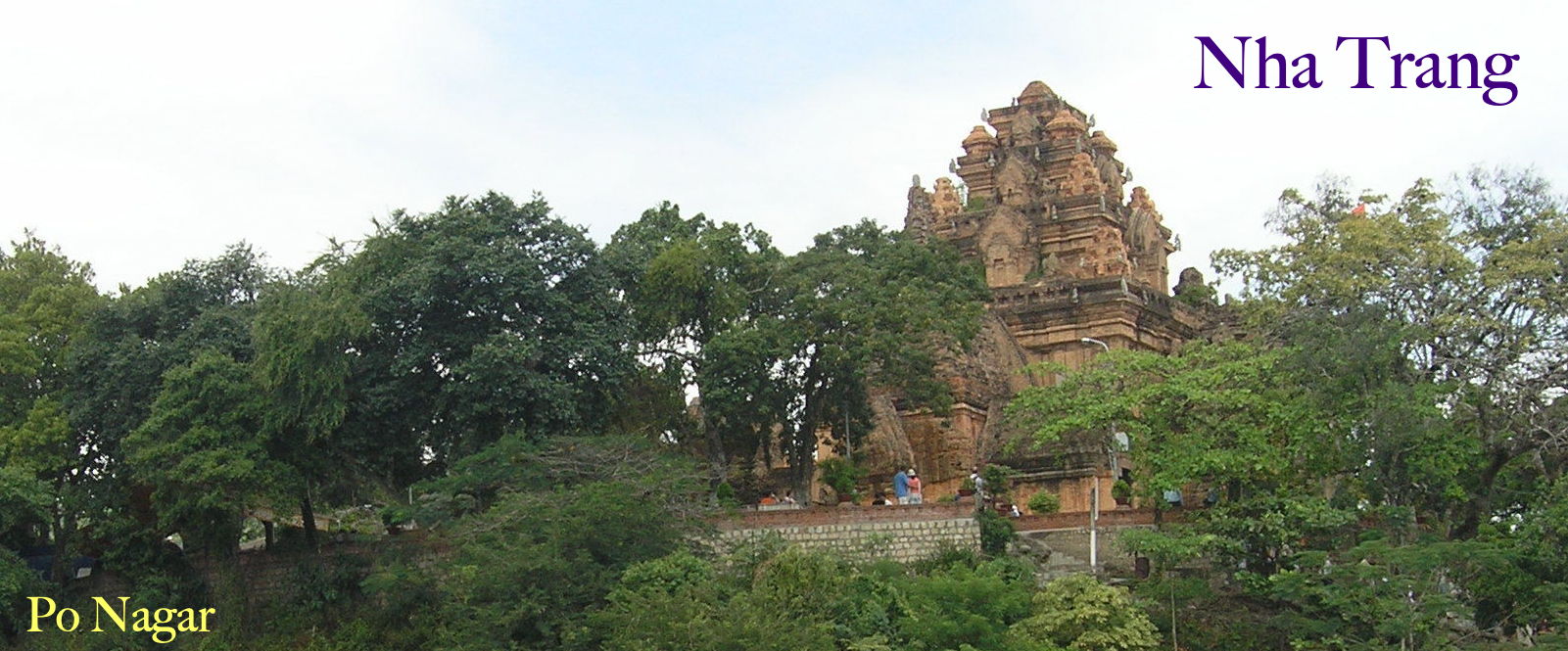NHA TRANG & PO NAGAR
As best I can remember, my fascination with the ancient realm of Champa first took form during my visit to Nha Trang as part of a biking tour in 2001. But I may have dreamed of such towers in southern Vietnam even earlier, sometime after my bike tour of 1999.
Nha Trang came into its own as an idyllic seaside town in the French colonial era—Alexandre Yersin, the famed Swiss-French bacteriologist, first arrived here in the 1890s and, after some notable adventures, made it his permanent residence (d. 1943). Nowadays, it still has a very charming beach, kept tidy for the tourist trade. A staggered palisade of high-rise hotels looms on the other side of the main drag, but the line of palm trees keeps them from overshadowing the lovely panorama.
The temple of Po Nagar is sheltered a bit from the bustle of town, perched on a wooded hillock that overlooks the harbor at the mouth of the Sông Cái. It is now a place of worship for the Kinh (ethnic Vietnamese), who have appropriated the goddess as their own, sometimes calling her a “Holy Mother” (Thánh Mẫu). Po Nagar is a bit different from the Holy Mothers who are worshipped in northern Vietnam, though Nguyễn Thế Anh and other scholars have argued that she was the inspiration for the cult of Princess Liễu Hạnh, foremost of the three (sometimes four) mothers of the Three (or Four).
According to Trần Kỳ Phương’s accounting, the inscriptions confirm that the goddess was first worshipped as Bhagavati (784, 817, 918, and 965), and later as Pô Yang Inu Nagar / Yapu-Nagara (1050, 1160, 1256, and 1275). The main statue at the temple is roughly dated to the 10th or 11th centuries, when the inscriptions referred to her as Bhagavati. As has frequently been noted by archeologists and other scholars, the head of the statue appears to be a replacement—Trần Kỳ Phương sees in it a Vietnamized style.
When draped in ceremonial robes, as I have typically found her, her shoulders and torso are concealed, leaving only the face exposed. Thus, her transformation (or repurposing) is similar to that of a Khmer statue of Siva in Châu Đốc that is similarly cloaked and is now worshipped as the Vietnamese goddess Bà Chúa Xữ (Lady of the Realm).
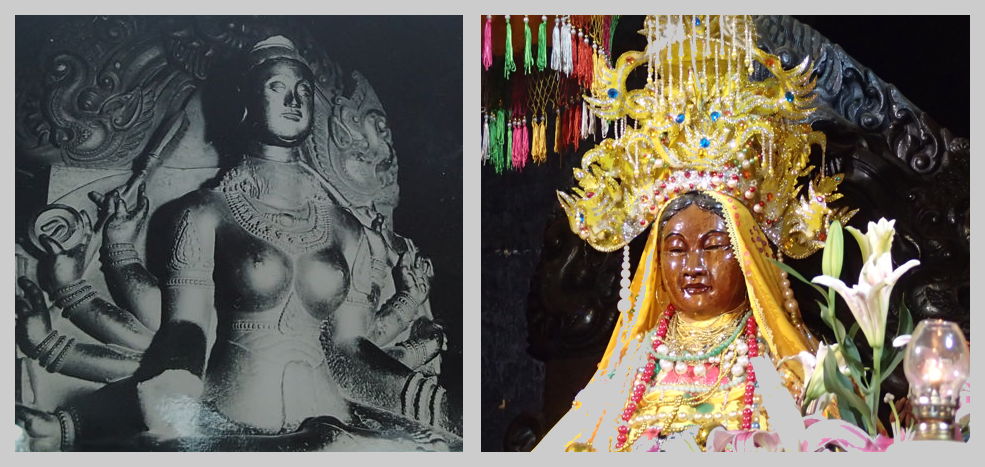
The statue photographed by archeologists (left) and as worshipped today (right).
We cannot go back in time to view the goddess cult as it was practiced in the era of Cham rule, but it is interesting to recall the observations of the first Europeans to visit her shrine. First among these was Étienne Aymonier, the self-made linguist and ethnographer who was assigned as a colonial officer to this region in 1885, shortly after it had come under French oversight. In his 1888 study of Khánh Hòa province, he noted that the two neighboring Vietnamese villages had taken over maintenance of the temple and held ceremonies there in the second and eighth lunar months, substituting their own traditional performances of singing and dancing for those of the Cham. Apart from these ritual celebrations, the goddess was supplicated year round by seagoing fisherfolk who took her as a guardian spirit.
In 1902, the renowned archeologist Henri Parmentier published a detailed study of the temple complex, giving a comprehensive description of the famous statue in the principal sanctuary:
More fortunate than many other shrines, the temple of Po-Nagar has retained its main deity. It is a figure of a woman with ten arms, seated Indian [style] on a lotus pedestal (fig. 10 and 11, upper part). She has both, anterior arms placed on the knees, the left hand extended, the palm above, in the gesture of the gift, the right hand raised vertically, the palm outside, in the gesture that reassures.
maybe a cymbal; the next right arm, an arrow, point down; the left, a hatchet, a harpoon or an elephant hook; the fourth on the right, a disc-ring [disc with a center hole]; the left, a broken attribute which seems to have been a conch; the fifth on the right, a spear, the point in the air; the left, a bow.
The torso is bare, the breasts voluminous; the belly shows the folds of fertile motherhood. The head was completely detached from the bottom: it is impossible to affirm that the one the statue is wearing today is the old one; under the gilding and the Annamese repairs, and by the unfortunate fact of the disproportionate lengthening of its neck, it lost its primitive character. However, she wears a mukuta and this fact guarantees at least her Cham origin. The deity is dressed in a sarong, which must cover clinging pants [tights; leotard].
The circumstances that led to the replacement of the statue’s head are unknown. It’s possible that the head was destroyed or carried off in Cham times—perhaps by invaders or perhaps during the 17th century struggles between the Ahier and Awar (Hindu and Muslim) groups of Kauthera. If so, a replacement may have been fashioned by the Cham themselves.
However, Parmentier and other writers tend to see “Annamite” characteristics in the face, which would indicate a much later date for the replacement. It is unlikely that the Vietnamese would have deliberately removed the head of such a potent spirit after adopting her and taking custody of the temple (for which they paid the remaining Cham). So what accounts for the loss of the original head—is it possible that the Cham took it with them? Ngô Văn Doanh and others have mentioned that the statue and cult of the goddess were transferred to the Cham community in Phan Rang. This might refer to smaller statues of the goddess, but one has to wonder if the head from the main sanctuary was taken elsewhere at this time.
Yet another early description of Po Nagar and her temple was published in 1910 by Gabrielle M. Vassal, who lived three years in Nha Trang with her husband, a French doctor. Ms. Vassal adds more intimate observations about the mysteries of the temple:
Architecture
The Po Nagar temple is unique in that it has a fairly-well preserved mandapa—a row of columns for an entrance-corridor to the main temple. Many Cham temples had a mandapa, but this is the only surviving example.
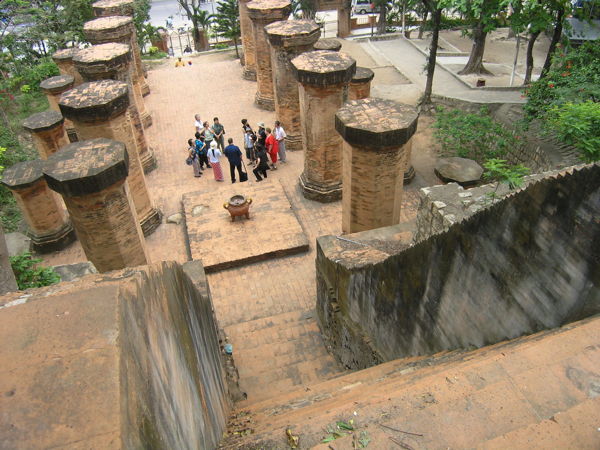
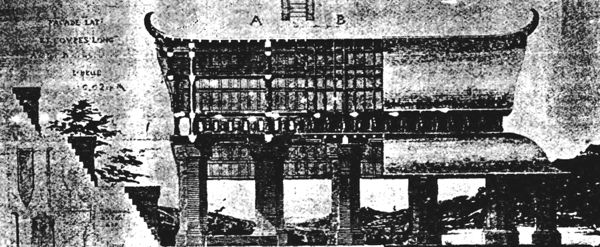
The mandapa and staircase viewed from the front of the main temple (top) and Parmentier’s hypothetical rendering of the mandapa from his 1902 article (bottom).
Each of the surviving temple towers is interesting, but the main sanctuary is truly remarkable. It is an outstanding example of the elaborate combination of miniature towers as part of the pyramidal roof construction. Trần Kỳ Phương writes that the overall shape of the roof is meant to replicate a mountain. However, seen from far away, it might well be mistaken for the crown of a tree. Seen up close, the precisely articulated design of the roof reveals a delicate organic complexity that is suggestive of leaves and branches. In this respect, it reminds me of the towers of Cánh Tiên (Bình Định), and Po Ro Me (Phan Rang). In comparison, I find the temples of Angkor leaden and monolithic.
Legends Pertaining of Po Nagar
As to the goddess, we can find signs of her in many places, in inscriptions as far away as Mỹ Sơn (near Đà Nẵng) and even in early Vietnamese writings. The first Vietnamese encounter with the goddess is reported in a 13th century compilation of tales about potent spirits (Việt điện u linh tập of the Vietnamese realm. In this story, the third emperor of the Lý dynasty encountered her spirit when leading an expedition south against the Cham in 1069. His fleet encountered a fierce storm when passing the mouth of the Hoàn river in Nghệ An province, but the goddess appeared to the emperor in a dream and promised her help. The next day, the emperor had his men scour the shoreline, and they found a twisted tree trunk that resembled the spirit that he had seen in his dream. He had the tree trunk brought on board and later brought it back to the capital (Thăng Long, today’s Hà Nội) and endowed a temple for the lady-spirit’s worship. Thus he hoped to enlist the help of an exotic goddess who exerted considerable influence in a contested region.
There is a stele on the temple grounds that records one version of the legend of Po Nagar, as written down by the famed mandarin Phan Thanh Giản in 1857. (After the French capture of Saigon, Giản became the chief negotiator for the Nguyễn court, eventually traveling to Paris to seek redress from Napoleon III.)
One side of the stele records Giản’s original composition (in Han Chinese characters) and the reverse provides a modern quốc ngữ translation. A loose rendering of the quốc ngữ translation in English:
Once upon a time on the mountainside of Đại An Mountain, a woodcutter and his wife built a house and began to grow melons. The ripe melons often got stolen. One day, by hiding and watching, he caught a young girl about nine or ten years old, who came out to pick the melons and then played around in the moonlight. Seeing she was quite lovely, and since the couple had no children, he brought her home and adopted her. The couple loved her as their own biological child.
One day, heavy rains and floods created a desolate landscape. The girl built three miniature mountains from stones and then stood back to admire them. Thinking that this behavior was improper for a woman, the woodcutter scolded her harshly. He did not know the daughter was a fallen spirit from heaven who longed for her original home. Sadness added to sulks, she merged herself into a sandalwood log that floated freely with the waves. The log drifted to sea, landed on a beach in China, where it pervaded the air with a marvelous fragance. This attracted curious local people. As it was of wood of good quality, they tried to pick up the log, but it would not be budged, regardless how many people joined in.
At the news, the Prince of the North Sea came to see the marvel. Looking at it, he thought that such a small log could not be too heavy to lift. When trying his hand, he was surprised to find the log was as light as a sheet of paper. He brought it back to his palace and treated it with great care as a valuable treasure.
One night, by the light of the moon, the prince glimpsed a human figure near where he kept the sandalwood log. When he came closer for a better look, it seemed that the place was deserted except for the vast fragrance from the driftwood. He hid and patiently watched for several nights but did not find anything strange. Still he was not discouraged. Then, one night when it was deathly quiet, a perfectly beautiful woman came out from the fragrant log. The prince rushed over and hugged her. Without time enough to diappear, the beauty consented to follow him into his palace and told him that she was called Thiên-Y-A-Na.
Although coming of age, the prince had not been able to find a suitable bride. He found Thiên-Y-A-Na extraordinarly beautiful and asked the king permission to marry her. The king approved. The couple lived happily together and gave birth to two children, of which Trí was the boy and Quý was the girl; both of them were pleasing in appearance. Time passed in peaceful harmony. One day, however, Thiên-Y-A-Na was overtaken by homesickness and she picked up her children, merged with them into the sandalwood log, and floated away to return to her home village.
The three of them found their way to Đại An Mountain but the woodcutter couple had passed away. Thiên-Y-A-Na built tombs for her adopted parents and turned the house into a worshipping place for them. Recognizing the barbaric state of local people, she taught them to plow, plant crops, spin, and weave fabrics. She set up rituals and customs… From that time on, fields were expanded, and local living standards improved. Then on an auspicious day, when the sky was bright and calm, a crane came down from the cloud. She and her children mounted on it and soared back to heaven.
In recognition of her merit, local people built the towers and a statue for worshipping. The anniversary of the day that she returned to heaven (the 23rd day of the third month on the lunar calendar) was celebrated with solemn ceremonies that included sacred dances and flower offerings.
From the Land of North Sea, after a long wait for the return of his wife and children, the prince sent a search party to Đại An. When it arrived, however, Thiên-Y-A-Na had left for her heavenly palace. These North Sea men suspected that the local people were lying and used their superior numbers to harass them; they offended the spirits and statues. The local people burnt incense and prayed. Immediately a storm and winds arose and drowned the ships from the North Sea Prince.
A big rock rose up at this place and was named Đá Chữ (Letter Stone).
According to the stele, Phan Thanh Giản took his text from a translation, presumably in a Cham script, so the English version given above is three times removed from the original. Fortunately, William B. Noseworthy has recently published much more direct translation into English of a Cham manuscript called the Daumray Po Nagar (published in SUVANNABHUMI in 2015, see below).
The basic storyline of the Daumray Po Nagar is quite similar to Giản’s version, though it has several colorful details that localize the story. The key differences may be significant, possibly reflecting the imposition of classical Chinese norms. In the Daumray Po Nagar, it is the couple together who spy the spirit in the melon patch and bring her home. There is no indication that the girl-spirit has fallen from heaven, and so there is no story of a stork flying the goddess and her children back to heaven.
The most consistent element is the merger of the spirit with the tree trunk, and the watery setting. The story of the tree floating across the sea to the Chinese coast is matched in Vietnamese legend by stories of the spirits of Chinese court ladies washing up on Vietnamese shores.
Parting Thoughts
Some French specialists consider the statue of the seated goddess to be a masterpiece of Cham sculpture, but it is far from being one of my favorites. For me, the appeal of the Po Nagar temple lies more in the pleasure of the architecture, the harmonious sense of place, and the aura of the goddess’s legend. Despite the stream of tourists, it is a rather peaceful place, where one can sit in the shade on a warm day and look out over the harbor at the rivermouth, with its armada of fishing boats.
I wonder if my quasi-compatriot Yersin spent time here. His biographers tend to concentrate on his scientific endeavors and say surprisingly little about his long years in Nha Trang. Did he spend all of his time looking at the stars, charting the coast, and working with tropical plants? I’d like to think he strolled over from time to time on an afternoon, but that may be just a projection of my own inclinations. If he missed the chance, c’est dommage.
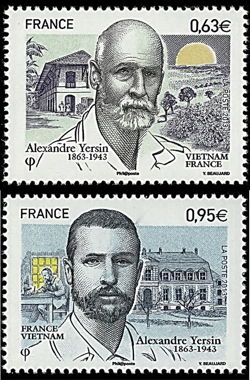
- Notes sur l’Annam, II. Khánh Hòa, Étienne Aymonier, Impremerie Coloniale, Saigon, 1888.
- “Le sanctuaire de Po-Nagar à Nhatrang,” Henri Parmentier Bulletin de l'Ecole française d'Extrême-Orient, Année 1902, Volume 2, Numéro 1.
- “Nouvelles notes sur le sanctuaire de Pô-Nagar à Nhatrang,” M. H. Parmentier, Bulletin de l'Ecole française d'Extrême-Orient, Année 1906, Volume 6, Numéro 1.
- “Découverte d'un nouveau dépôt dans le temple de Po Nagar de Nha-trang,” Henri Parmentier, Bulletin de l'Ecole française d'Extrême-Orient, Année 1909, Volume 9, Numéro 1.
- Inventaire Descriptif Des Monuments Čams De L'Annam, Henri Parmentier, E. Leroux, Paris, 2009.
- On & Off Duty in Annam, Gabrielle M. Vassal, W. Heinemann, London, 1910 (pp. 222-226)
- La Statuaire du Champa, Jean Boisselier, Ecole française d'Extrême-Orient, Paris, 1963 (pp. 207-210).
- “The Vietnamization of the Cham Deity Po Nagar,” Nguyễn Thế Anh, in Essays into Vietnamese Pasts, edited by K. W. Taylor and John K. Whitmore, Cornell Southeast Asia Program, 1995.
- “The Cult of the Holy Mothers in Central Vietnam,” Dong Vinh, Vietnamese Studies, 1999, No. 1, page 73.)
- "Goddess on the Rise", Philip Taylor, University of Hawai’i Press, 2004 (pp. 65-66)
- Champa Ancient Towers: Reality & Legend, Ngô Văn Doanh, Thế Giới Publishers, Hanoi, 2006 (pp. 187-218).
- “The Mỹ Sơn and Pô Nagar Nha Trang Sanctuaries: On the Cosmological Dualist Cult of the Champa Kingdom in Central Vietnam as Seen from Art and Anthropology,” Trần Kỳ Phương & Rie Nakamura, Asia Research Institute Working Paper Series No. 100, February 2008.
- “The Mother Goddess of Champa: Po Ina Nagar,” William B. Noseworthy, SUVANNABHUMI: Multi-Disciplinary Journal of Southeast Asian Studies, 7(1), 2015.
- Yersin : un pasteurien en Indochine, Henri H Mollaret and Jacqueline Brossollet, Belin, Paris, 1993.
